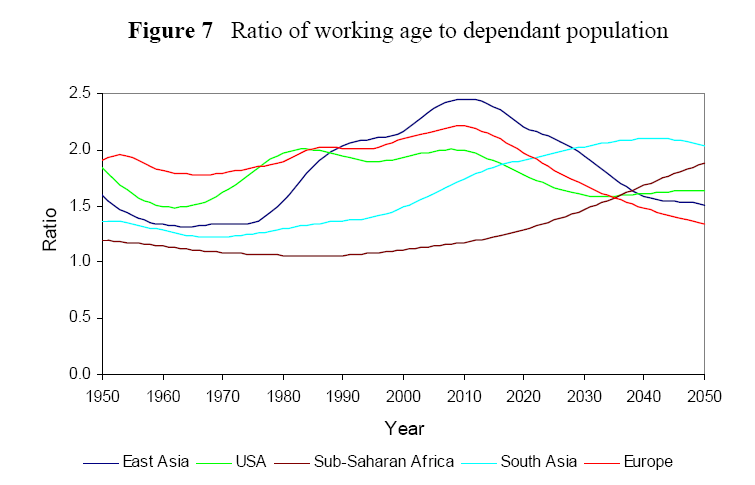Review of readings:
- Global Trends 2025, Chapter 2: The Demographics of Discord.
- Who's Aging? Europe, Japan, China, U.S.
In the U.S. the trend is lessened because of high immigration. Japan has a triple whammy, because not only is it aging, but it integrates immigrants very badly and it makes little use of women in the workforce (as highlighted very well by Justyna's article this week). - Why? increased lifespans, lower fertility, low immigration/high emigration
- Why is a greater proportion of seniors a problem? Lower workforce, pensions and health costs
- Who's Got Youth Bulges? South America, Northern Africa/Middle East, Sub-Saharan Africa, South Asia, parts of Pacific Islands
- Why is it called an Arc of Instability? Youth can be a volatile element in society, especially if they do not have jobs.
- What turns a youth bulge into a worker bulge? education, health, jobs, infrastructure, money/good governance
- Where are people migrating from? to?
- From areas of lower economic and physical security to areas of higher security: US and Europe, but also China, India, Brazil, Mexico.
- A lot of South-South migration, from basket-cases to not-quite-as-much a basket case (e.g. from Haiti to Dominican Republic, DR of Congo to Central African Republic, etc.).
- Also from rural to urban areas. Now over half of human population in urban areas.
- Causing shifts in ethnic balance, political shifts.
- Some countries may be getting "brain gain", reversing "brain drain", with successful people seeing more opportunities in their home countries (China, India, Brazil, Mexico).
- Who's Aging? Europe, Japan, China, U.S.
- Gladwell, "The Risk Pool," Section 2.
- Dependency ratios (young + old)/working age have a big impact on economic success. Yvonne asked in class what was so bad about a dependency ratio of just over 1-to-1, that Sub-Saharan Africa has. My answer was that on the one hand, it's compared to what, and as some others in the class pointed out, it was also an absolute case of not having extra resources to invest, and just getting by at a subsistence level. Here is a very revealing chart from "Global Demographic Change: Dimensions and Economic Significance," a Harvard Initiative for Global Health Working Paper by David E. Bloom and David Canning (the authors Gladwell mentions in his article):
- "What's critical is not just the growth of a population but its structure."
- A "demographic transition" from high mortality and high fertility to lower mortality and lower fertility can lead to a big demographic dividend, where the last big cohort of young people mature into workers (given good policies) who don't have to support as many young people themselves. This happened in Ireland and some other countries, and some countries now are hoping to have it happen (e.g. India). China is struggling to "get rich before it gets old". For a fun exercise in identifying the shape of populations as they go through a demographic transition, try this page. For a nice interactive simulation of world, regional, and country populations, using historic data and U.N. population projections, see this page and launch the movie.

- Zakaria: U.S. is doing better than Europe and Japan because it welcomes and integrates immigrants. Immigration policies are key to maintaining productivity, innovation... hunger.